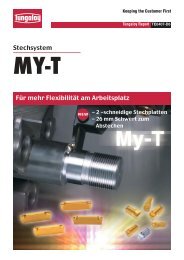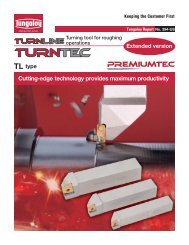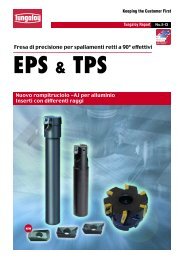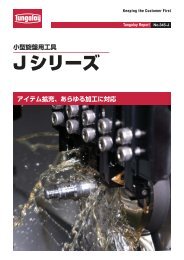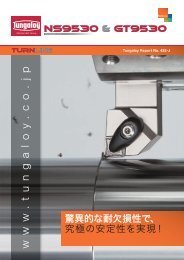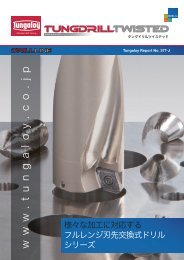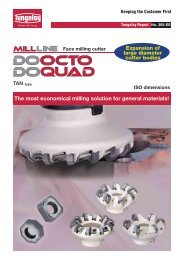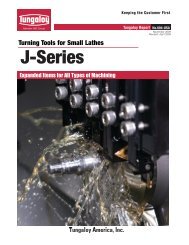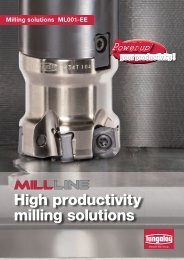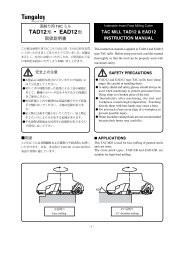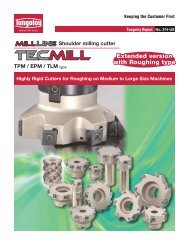PDFï¼7.7MB
PDFï¼7.7MB
PDFï¼7.7MB
You also want an ePaper? Increase the reach of your titles
YUMPU automatically turns print PDFs into web optimized ePapers that Google loves.
EPH<br />
Standard cutting conditions<br />
Shoulder milling<br />
Work<br />
material<br />
Cutting Feed per<br />
Cutting conditions<br />
speed tooth<br />
Vc (m/min) fz (mm/t) ø10 øDc < ø12 ø12 øDc < ø16 ø16 øDc ø26<br />
9<br />
TAC Mills<br />
ap<br />
ap<br />
ae<br />
ap: Axial depth of cut<br />
ae: Radial depth of cut<br />
Slotting<br />
Carbon steels<br />
Alloy steels<br />
(< 30HRC)<br />
Alloy steels<br />
prehardened<br />
steels<br />
(30 ~ 40HRC)<br />
Stainless<br />
steels<br />
(< 250HB)<br />
Grey<br />
cast iron<br />
Ductile<br />
cast iron<br />
Aluminium<br />
alloys<br />
(Si < 13%)<br />
Aluminium<br />
alloys<br />
(Si 13%)<br />
60 ~ 180 0.03 ~ 0.1<br />
50 ~ 150 0.03 ~ 0.08<br />
50 ~ 150 0.03 ~ 0.06<br />
80 ~ 200 0.03 ~ 0.1<br />
60 - 160 0.03 ~ 0.1<br />
100 ~ 300 0.03 ~ 0.1<br />
80 ~ 180 0.03 ~ 0.08<br />
ap 7.5 mm<br />
ae 1.5 mm<br />
ap 5.5 mm<br />
ae 1.5 mm<br />
ap 4.5 mm<br />
ae 1.5 mm<br />
ap 9.5 mm<br />
ae 2.0 mm<br />
ap 9.5 mm<br />
ae 2.0 mm<br />
ap 9.5 mm<br />
ae 2.0 mm<br />
ap 9.5 mm<br />
ae 2.0 mm<br />
Vc = 120 m/mim, fz = 0.08 mm/t<br />
ap 9.0 mm<br />
ae 1.5 mm<br />
Vc = 100 m/min, fz = 0.05 mm/t<br />
ap 6.5 mm<br />
ae 1.5 mm<br />
Vc = 100 m/min, fz = 0.04 mm/t<br />
ap 5.5 mm<br />
ae 1.5 mm<br />
Vc = 140 m/min, fz = 0.08 mm/t<br />
ap 11.5 mm<br />
ae 2.0 mm<br />
Vc = 110 m/min, fz = 0.08 mm/t<br />
ap 11.5 mm<br />
ae 2.0 mm<br />
Vc = 200 m/min, fz = 0.07 mm/t<br />
ap 11.5 mm<br />
ae 2.0 mm<br />
Vc = 130 m/min, fz = 0.06 mm/t<br />
ap 11.5 mm<br />
ae 2.0 mm<br />
ap 12.0 mm<br />
ae 2.0 mm<br />
ap 9.0 mm<br />
ae 2.0 mm<br />
ap 7.5 mm<br />
ae 2.0 mm<br />
ap 15.5 mm<br />
ae 3.0 mm<br />
ap 15.5 mm<br />
ae 3.0 mm<br />
ap 15.5 mm<br />
ae 3.0 mm<br />
ap 15.5 mm<br />
ae 3.0 mm<br />
Cutting Feed per<br />
Work<br />
Cutting conditions<br />
speed tooth<br />
material Vc (m/min) fz (mm/t) ø10 øDc < ø12 ø12 øDc < ø16 ø16 øDc ø18 ø18 < øDc ø21 ø21 < øDc ø26<br />
Carbon steels<br />
Vc = 100 m/mim, fz = 0.06 mm/t<br />
Alloy steels 60 ~ 180 0.03 ~ 0.1<br />
(< 30HRC)<br />
ap 1.5 mm ap 2.0 mm ap 3.0 mm ap 2.5 mm ap 2.5 mm<br />
Alloy steels<br />
Vc = 70 m/min, fz = 0.05 mm/t<br />
prehardened<br />
steels<br />
50 ~ 150 0.03 ~ 0.08<br />
(30 ~ 40HRC)<br />
ap 1.0 mm ap 1.5 mm ap 2.0 mm ap 1.5 mm ap 1.5 mm<br />
Stainless<br />
steels<br />
(< 250HB)<br />
Grey<br />
cast iron<br />
50 ~ 150 0.03 ~ 0.06<br />
80 ~ 200 0.03 ~ 0.1<br />
Vc = 70 m/min, fz = 0.04 mm/t<br />
ap 1.0 mm ap 1.0 mm ap 1.5 mm ap 1.5 mm ap 1.5 mm<br />
Vc = 120 m/min, fz = 0.07 mm/t<br />
ap 3.5 mm ap 4.0 mm ap 4.5 mm ap 3.5 mm ap 3.0 mm<br />
Ductile<br />
cast iron<br />
Aluminium<br />
alloys<br />
(Si < 13%)<br />
Aluminium<br />
alloys<br />
(Si 13%)<br />
60 ~ 160 0.03 ~ 0.1<br />
100 ~ 300 0.03 ~ 0.1<br />
80 ~ 180 0.03 ~ 0.08<br />
Vc = 80 m/min, fz = 0.07 mm/t<br />
ap 3.5 mm ap 4.0 mm ap 4.5 mm ap 3.5 mm ap 3.0 mm<br />
Vc = 150 m/min, fz = 0.07 mm/t<br />
ap 3.5 mm ap 4.0 mm ap 4.5 mm ap 3.5 mm ap 3.0 mm<br />
Vc = 110 m/min, fz = 0.06 mm/t<br />
ap 3.5 mm ap 4.0 mm ap 4.5 mm ap 3.5 mm ap 3.0 mm<br />
Notes:<br />
When slotting, use a rigid machine.<br />
When chips stay in the cutting zone during slotting or<br />
pocketing, use air to remove chips from the work area.<br />
If chips tend to stick to the cutting edge (such as aluminium<br />
alloy machining), use a water soluble cutting fluid.<br />
If cutting a casting skin or heavily interrupted work surface,<br />
decrease the feed per tooth and maximum depth of cut to<br />
1/2 to 2/3 times the values shown in the table.<br />
Tool overhang length must be as short as possible to<br />
avoid chatter. When the tool overhang length is long,<br />
decrease the number of revolutions and feed.<br />
Cutting conditions are generally limited by the rigidity<br />
and power of the machine and the rigidity of the<br />
workpiece. When setting the conditions, start from<br />
half of the values of the standard cutting conditions<br />
and then increase the value gradually whilst making<br />
sure the machine is running normally.<br />
9–76



